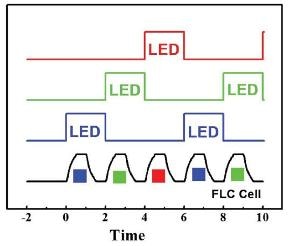Mar 7 2018
A team from the Faculty of Physics, MSU along with their international colleagues created a new liquid crystal material possessing high potential as a foundation for faster, brighter, energy-saving displays with higher resolution. The results of the research have been published in Advanced Functional Materials journal.
 This is an illustration of color combination in time within a display pixel. (Image credit: Alexander Emelyanenko)
This is an illustration of color combination in time within a display pixel. (Image credit: Alexander Emelyanenko)
The LCD devices can be found in nearly every home. The most basic ones are the calculators, watches, and players, and the more advanced level is characterized by the screens of TV sets, computers, tablets, smartphones, and other electronic devices. The display images contain many pixels - the smallest physical elements of an LCD.
Each pixel of a conventional LCD based on the nematic liquid crystal (NLC) is a combination of the three sub-pixels: red, blue, and green. An LCD material within each pixel is, actually, a color filter making a sandwich-like structure, in which the "filling" is formed by the two glasses with transparent electrodes within and a liquid crystal between them, while the outer portions of the "sandwich" are the polarizers. Both polarizers create the linear polarization of light but in perpendicular directions.
Each pixel of a conventional display is filled with NLC containing perpendicular orientations of molecules on the opposite glasses. The first polarizer creates the linear polarization of light in a specific direction. Without an electric field, the polarization plane of the light rotates by 90 degrees traveling between the glasses, so that the polarization plane on the output of the cell coincides with the polarization plane of the second polarizer. Here, the light propagates via the cell, and the pixel is bright.
All molecules are oriented along the electric field when the electric field is applied, and there is no rotation of the polarization plane of the light between glasses, thus the second polarizer cuts-off the virtually whole light propagating via the cell, and the cell is dark in this case. The color in the conventional displays is created by illumination of each particular sub-pixels by red, green, or blue, while the liquid crystal within each pixel is either absorbing (if the voltage is on) or transparent (if the voltage is off) for the light. In the end, the colored image is created by a particular combination of the red, green, and blue sub-pixels. This principle was explained by the Soviet physicist Vsevolod Frederiks and is presently used in most of the LCD devices.
We've developed a liquid crystal material of another kind - a ferroelectric liquid crystal (FLC), which is stable to the mechanical stress (the major problem in FLC's). FLC possesses the spontaneous electrical polarization that allows one to enlarge the order of the operation speed several times of magnitude. FLC materials allow one to use the field sequential color display, in which the red blue and green light are averaged by the human's eyes in time, but not in space.
Alexander Emelyanenko - Professor of the Russian Academy of Sciences, Doctor of Physical & Mathematical Sciences, Leading Research Associate of the Chair for the Physics of Polymers and Crystals, Department of Solid State Physics, MSU
The material created by the researchers has the stable FLC structure in a wide variety of temperatures which makes it impervious to temperature fluctuations. In new displays, all three backlighting colors can be triggered in a certain rapid sequence across the entire screen, while each liquid crystal pixel can be "opened" and "closed" faster. Experiments have revealed that the replacement of the three sub-pixels with only one will allow the audience to appreciate a more realistic, bright, and contrast images without the color blurring.
Conventional LCDs based on NLC absorb around 2/3 of the backlight because of the use of three individual color filters that are integrated into the structure of a display for developing a full-color image. Such displays require more robust light sources. In new displays, each pixel will be open for the light propagation during a specific time, which is required to blend the colors in time.
The development of the field sequential color displays will make their production considerably cheaper and improve their optical characteristics such as brightness, color gamut, and resolution (as each pixel will work on its own, not as one of the three subpixels). This will also help save up to 70% of energy consumed by a display, as the source of light may be made much less bright without affecting the brightness of the screen.
Alexander Emelyanenko - Professor of the Russian Academy of Sciences, Doctor of Physical & Mathematical Sciences, Leading Research Associate of the Chair for the Physics of Polymers and Crystals, Department of Solid State Physics, MSU
The research was conducted along with scientists from the University of California, Berkeley, and the National Chen Kung University (Taiwan).